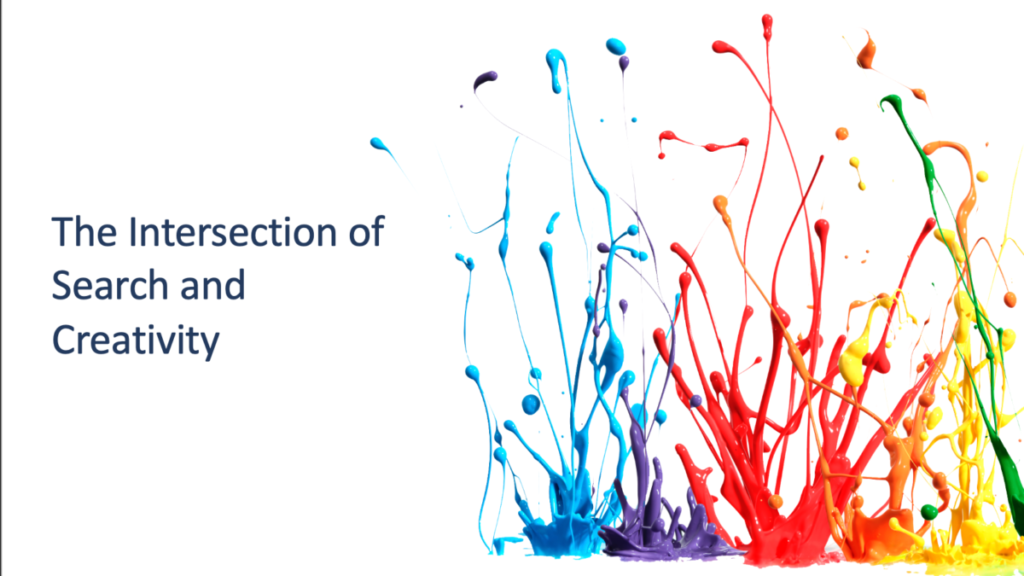
I’m going to go out on a limb here. When most B2B marketers imagine a role that would give them the opportunity to think and talk about creativity, a role engaging audiences with paid search isn’t what springs to mind. If somebody left a position heading up content and social for LinkedIn Marketing Solutions so that they could spread the word about PPC campaigns, then you’d probably assume that the creative side of advertising wasn’t what made them tick. Maybe spreadsheets, analytics and nerdy attention to technical detail would be more their thing.
Well, I am that content marketer. I landed at Bing just before Christmas after five fantastic years at LinkedIn. I’m actually very proud of my inner nerd and I’ve spend much of my career in content marketing obsessively studying search. However, I’m nothing like as obsessed about it as I am about the role of creativity in marketing and advertising. The fact is, I see no contradiction in a creative-minded content marketer jumping to a role talking about search. That’s because I believe paid search is one of the most important creative opportunities in marketing today.
In search of creative search campaigns
Shortly after I landed at Bing, I found myself in conversation with a member of the Microsoft Insights team, who put it far better than I ever could. “Search,” he said, “is the most genuine expression of people’s thoughts that you’ll find.” It’s true of course – and it’s an idea that should excite any marketer who’s genuinely passionate about getting beneath the skin of their audiences, and connecting to them on a different level.
As search marketers, we deal in a unique form of personalised media opportunity based on what someone is thinking about – and how they’re thinking about it. Search behaviour may take place at scale, but for each individual searcher, it’s a very intimate experience. When we apply creativity to the different aspects of creating that experience, we dramatically expand the scope of what search can do. We create greater impact, we use budgets more effectively, we take people on journeys rather than just handing them information.
Like many marketers who use search, I’ve tended to follow the strategy of doing the obvious and signalling what you’re doing as clearly as possible. We know that keyword relevance and quality score are hugely important to how our PPC ads perform – and so we happily allow these things to dictate every aspect of our activity: the keywords that we choose to target, the way that we group them, the ad copy and creative. The trouble with this approach is, almost everyone else in your sector is following it as well. The result is pages of search results all looking almost exactly the same. And when all the PPC ads are indistinguishable, position becomes more important, and your bids have to go up.
By doing the obvious, marketers also end up buying into a search lottery. If we’re too busy being a slave to the most intent-focused keywords and the assumed demands of the quality score, we don’t focus on differentiating for different audiences and trying to pre-qualify the clicks that are most valuable to our business. We end up looking at cost per click, but ignoring cost per conversion.
The dimensions of creativity in search
So, in the couple of months since I arrived at Bing, I’ve been asking myself where the creative opportunities in search are – and what the value is of taking those creative opportunities. For my own benefit (and partly to beat myself up for occasions when I’ve been too obvious in the past), I want to build the business case for approaching different elements of paid search planning and execution with a creative mind. I’ve discovered that there are superb examples of creativity in search delivering very tangible results for different marketing objectives at different stages of the funnel. But I’ve also become convinced that there are far fewer examples of this than there should be. Paid search isn’t just one of the most significant and unique creative opportunities in marketing – it’s also one of the most underrated and neglected.
I believe the creative opportunities in search fall into five main areas: creative strategies around the moments that lead to search, creativity in our approach to keywords, creativity in the content of search ads themselves, a creative approach to the ongoing journey that starts with the search, and creativity in how we use the data that search generates.
There are huge rewards for creativity at all of these different points in the search marketing process – and the changing nature of search itself means that these rewards are increasing.
What does creativity mean anyway?
But before I start exploring how and why we’d want to be more creative in paid search, it’s worth pausing to consider what we mean by creativity in the first place. It’s always been a concept that marketers value – but which they struggle to define precisely. Over the last few years, I’ve spent quite a bit of time interviewing award-winning agency creative directors and marketers for The Sophisticated Marketer’s Podcast – and I often ask them how they go about defining creativity. The answers range widely. However, there are some common themes: creativity is not an exact science, and its value can’t just be measured in terms of sales; serendipity has at least as important a role as logic; creativity makes data a springboard for thinking, not an anchor holding it back. A comment that I think is particularly relevant to paid search is this: “data makes creativity more effective, and creativity makes data more valuable.”
One of the most influential thinkers on creativity in marketing was the legendary advertising pioneer, who helped to develop the concept of the inherently creative “big idea.” For Ogilvy, a big idea came along only very rarely (he claimed to have had only 20 in his life). This inherently creative moment of inspiration is unique, original – and fits the strategy behind the product or service you are marketing to perfection. Ogilvy’s own recipe for big ideas involved careful research, submerging yourself in all data and insight available on your audience, what they needed and how they thought about your sector. Then you allowed time and space for your unconscious to get to work and mash these different ideas together to produce something unexpected and yet still inherently relevant.
Defining search moments
As I’ve mentioned, a search query provides us with a vivid snapshot of somebody’s thought processes at a particular point in time. But as creative search marketers, we don’t have to wait for that query to be typed into a search box or spoken to a digital assistant in order to start engaging with the moment. We can anticipate when and why people might have a desire for information, plan our strategy around the type of motivation they have, and engage earlier in their journey. We can start thinking creatively about the potential triggers for search.
One of those triggers is the gorgeous photograph that appears when a Microsoft PC screen-locks. The Dutch National Lottery and its agency Greenhouse Group, which is one of Bing’s innovation partners, recognised that this is a potentially very powerful, aspirational moment. People look at that image and start thinking about where on the earth they might want to be, where they would travel to and spend their time if they could afford it – if they had more control over their life. They’d identified a moment immensely relevant to their product – and they knew that the natural next step for somebody experiencing that moment could be search. That gave them the opportunity not just to advertise to someone looking at a piece of media, but to become part of their thought process.
Greenhouse Group worked with Bing and Microsoft to develop a click box that identified the destination featured in each photograph, and enabled a Bing search on that destination. They then bid aggressively on that destination keyword. In doing so, they designed an aspirational and inherently interactive ongoing journey, where the user took the initiative in researching their dreams – and the Dutch National Lottery became the vehicle looking for them. They expanded the concept of what a Bing search opportunity is – and that produced massive scale and exceptional results: a 709% increase in the total volume of accounts and 99x increase in non-branded search.
Other approaches to taking control of the moment of search give scope for creativity in different ways. A recent study that Bing conducted in Italy showed how adapting brand-building TV ads to incorporate a search-related call to action drove sustained increases in engagement and activity for the online retailer, ePRICE. Within two minutes of these ads airing, the volume of brand searches grew by 50%. Over the following weeks, it remained elevated, at 37% higher than the control. Linking your different channels is a simple approach – but it’s a highly effective one and it gives you a creative canvas to leverage in shaping search moments.
Creative keyword targeting
When we move on from the moment that initiates a search, and into the search experience itself, the creative opportunity becomes the keyword that a searcher uses. Now, as a paid search marketer myself, I’ve always thought of keywords as a supremely conscious, considered and logical signal of intent. There’s no call for fluffy stuff here: we’ve got an audience telling us exactly what they want and we need to compete with others to be at the top of the list for giving it to them.
It’s true that a lot of searches are like this – and when those signals of intent are relevant to your strategy, you have to go out and compete for your position with relevance, quality, the right bid and (spoiler alert) a creative approach to standing out.
However, not every search is like this. Not every search is just about as clear, purely logical signal of intent. Searches don’t just reveal the information people are after. They also reveal the mindset they are occupying when looking for that information, and there’s a huge opportunity space for engagement here.
Perhaps the most famous example of leveraging keywords more creatively is Snickers, which targeted the most common misspellings of the most common search terms and created a vast media opportunity for its “You’re not you when you’re hungry campaign.” The ad creative played on the misspelling, cheekily suggested the cause of it, and delivered a powerfully relevant brand and product message. In theory, the cleverest aspect of it was the fact that Snickers could achieve all of its desired impact without a click – and therefore without spending budget. As it turned out, the click-through rate was an unexpectedly high 1% – and as paid search marketers this should tell us something. When we push beyond the obvious intent and try to connect on a deeper, more human level, we drive strong engagement. And how we leverage that is up to us.
Keywords don’t just tell you more when they’re misspelled. Rather than just thinking about search queries in terms of whether they are navigational, informational or transactional, we have the opportunity to identify those that are aspirational, wistful, regretful or thoughtful. And keywords don’t just enable us to connect to the mindset of the searcher – we can connect to how the search is happening. Targeting signals of voice search provides the opportunity to stand out creatively, by referencing the fact that you are part of a conversation. And as voice takes a growing proportion of searches overall, we’ll be able to tailor search ads to turns of phrase, and means of expression, that give away more about how the searcher is feeling. Converse made headlines a few years ago for its ‘Domaination’ campaign targeting the life-and-the-universe type questions that teens ask search engines at particular stages of life and particular times of the year. The brand set out to claim that mental space for itself. In the voice era, these type of opportunities will be multiplied enormously – and the experiences we’ll be able to create leveraging them will be far more emotive as a result.
Not the information you’re looking for
As marketers, we tend to assume that the only type of informational search that’s relevant to our product is research of a potential purchase – or a search that indicates a need for a product they’re not yet aware of. However, search can involve seeking other types of information that provide broader brand opportunities by creating a media moment.
Research from the University of Oxford last year found that 20% of people get their news through search engines – and that enables paid search to align your brand with the headlines. Creatively speaking, you have the opportunity to do this either intuitively or counter-intuitively. There’s an obvious case for a brand associated with a celebrity bidding on keywords connected to recent news about that celebrity – especially with a creative approach to copy that’s responsive to the news itself. However, there are less obvious newsjacking opportunities connected to smashing people’s expectations of what they’ll find on a search page. The most famous example of this is Ann Summers’ hijacking of searches on a British Airways strike, the 2010 General Election and Chinese New Year as an opportunity to serve wholly irrelevant and yet very entertaining ads for lingerie and sex toys. It was a campaign that treated search as paid media: knowing what was on people’s minds and then deliberately disrupting that to gain attention.
The creative challenge for search ad copy
Playing with searchers’ expectations is one way to stand out through search ad copy – and punch above your position on the SERP in terms of earning attention. However, for most search campaigns, most of the time, the opportunity and challenge are different. You want to align with the searcher’s intentions in the same way that everyone else is seeking to align with their expectations. Where’s the scope for creativity in those situations? Do we have to settle for signalling relevance to keywords as obviously as possible, bidding high and playing by the rules to get our quality score up there?
It’s true that there’s a fixed goal at work – but there are many more creative ways to achieve that goal than you’d imagine from looking at most SERPs. Frustrated journalists and sub editors ask what creative opportunities remain for people with the craft to turn limited space into a witty, compelling yet inherently relevant headline and intro. The answer’s obvious – they’re in search!
The best search ad copywriters know that you can signal relevance through keywords while still playing with how those keywords are presented in the ad. Relating emotive adjectives to the keyword in question works in social media – so why not in search? Why dictate an answer when you can invite greater emotional engagement through a rhetorical question (see what I did there)? Play with alliteration, subversions of clichés and familiar phrases – and test, test, test to see which creative approaches work best.
Designing the ongoing search experience
It goes without saying that clicks on search ads are most valuable when they lead to sales. However, it’s unrealistic to expect all types of sales deals to close on the page or website visit that search ad immediately leads to. It also distorts the approach to search advertising. It leads to a Groundhog Day situation where search ad teams feel the pressure to complete a seduction, persuading a searcher to be swept off their feet and fully commit, within the bounds of a single experience. The result? We can come off as too needy, too pushy, too insincere – and we blow our chance.
When we stretch the creative opportunity for search to encompass the ongoing searcher journey, we give ourselves the time and space to build a genuine connection, and stronger conviction on the part of the searcher themselves. That’s what happened when Bing worked with the Dutch garden furniture retailer Kees Smit, to integrate search into the in-store experience. We recognised that garden furniture is something that many shoppers like to see in situ, and so the next step from a search ad isn’t necessarily a purchase – it’s more likely to be a store visit. However, because this is a high-consideration purchase, the store visit may not be enough to close the deal either. This extended buyer journey created two sets of problems: how can we effectively measure the contribution that search is making and optimise budgets and bids accordingly? And how can we tie the offline and online experiences together to make sure that we keep the brand and its products front-of-mind?
Kees Smit took control of this omni-channel shopper experience by integrating NFC and QR tags into the in-store experience, and inviting shoppers to access additional information online. The data captured quickly demonstrated the real ROI of Bing ads in driving shoppers to stores, trebling the revenue attributed to them. This freed up further budget, which could be invested in retargeting customers who had visited stores but not completed a purchase, bidding higher for those further advanced along the buying journey.
Creativity from search data
It goes without saying that search runs on data: aggregated data on what people are searching for and performance data that enables us to analyse and optimise campaigns in a way that’s highly responsive. There are obvious, intuitive ways to get value from this data – targeting relevant signals of buying intent, for example, or shifting more budget to ads that deliver a stronger CTR. However, there are more creative ways of applying it too. For marketing thinkers like David Ogilvy, the ability to think differently about data and insight was the essence of creativity. And with more data available, we have more creative opportunity than ever before.
We tend to apply search data in the present tense – our campaigns are designed to respond to the opportunities revealed right now. However, analysing search patterns can help to plan broader marketing strategies in the future as well. That was the genius in Kleenex’s use of search data in the UK a few years ago. It bid on keywords associated with searchers self-diagnosing cold and flu on search engines, generating the data it needed to identify which regions of the country were suffering a live flu outbreak. It then directed media spend across all channels to that region. As a result, 96% of the brand’s total media spend went to regions suffering a live flu outbreak and sales grew 40% year on year. The genius behind this campaign was recognition that search isn’t necessarily the prime channel for an FMCG purchase – but search can still play a creative role in directing overall media spend through the data that it generates.
Creative use of data can play an equally significant role when it comes to optimising search campaigns themselves. Imagine that you’re running search ads and considering whether ‘Free delivery’ or ‘Fast delivery’ is a more effective hook for your audience. The obvious thing to do is to AB test your creative and see which promise drives a higher CTR. However, this only gives you part of the picture. Looking deeper into the data and investigating the average order size that these clicks lead to is likely to give a lot more useful context. In many sectors, larger order sizes from B2B customers attach more value to the speed of delivery, whereas individual orders from consumers are more concerned with saving money on delivery. Looking deeper reveals where segmentation can add value – and could take your creative approach in wholly new directions.
Why creativity in search matters more than ever
For me, the thrill of being a creative-minded marketer working in search is the opportunity to smash together two elements of marketing that I have massive respect and nerd-like interest in. I love poring over data, valuing media opportunities and crunching numbers. And I love pushing the creative boundaries of what you can do with that insight. Search is the areas of marketing where the variety of data that we have to play with – and the variety of creative uses that we can put that data to – are growing fastest. Voice search will be massive in inviting searchers to reveal more about the moments and mindsets they occupy than ever before. AI will be massive in enabling us to analyse that data like never before: looking at it from different angles and asking different questions of it. And creativity will be a required element in how we respond to the opportunities that this creates. Because insight brings us closer to searchers, we’re going to need to be more intimate, more emotive and more relevant in how we respond.
David Ogilvy would have loved this opportunity – and I’m hugely excited about it as well.






